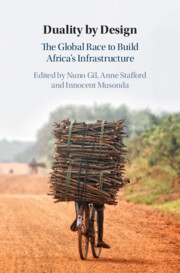Book contents
- Reviews
- Duality by Design
- Duality by Design
- Copyright page
- Contents
- Figures
- Tables
- Contributors
- Foreword
- Acknowledgements
- 1 Duality by Design: The Global Race to Build Africa’s Infrastructure
- Part I Mitigating Institutional Voids by Design
- 2 Why the Lights Went Out: A Capability Perspective on the Unintended Consequences of Sector Reform Processes
- 3 When the Quest for Electricity Reform and the Need for Investment Collide: South Africa, 1998–2004
- 4 Institutional Enablers of Energy System Transition: Lessons from Solar Photovoltaic Electricity in Eight African Countries
- 5 Harnessing Africa’s Energy Resources through Regional Infrastructure Projects
- 6 Centralized vs. Decentralized Generation in Zambia: Meeting Electricity Demand in the Context of Climate Change
- 7 Delivering Healthcare Infrastructure and Services through Public–Private Partnerships: The Lesotho Case
- 8 Achieving Long-Term Financial Sustainability in African Infrastructure Projects
- 9 A Proactive Social Infrastructure Model for Future Mixed-Use Housing in Egypt
- 10 Collective Action under the Shadow of Contractual Governance: The Case of a Participatory Approach to Upgrade Cairo’s ‘Garbage Cities’
- Part II Exploiting Institutional Voids by Design
- Afterword
- Index
- References
4 - Institutional Enablers of Energy System Transition: Lessons from Solar Photovoltaic Electricity in Eight African Countries
from Part I - Mitigating Institutional Voids by Design
Published online by Cambridge University Press: 14 November 2019
- Reviews
- Duality by Design
- Duality by Design
- Copyright page
- Contents
- Figures
- Tables
- Contributors
- Foreword
- Acknowledgements
- 1 Duality by Design: The Global Race to Build Africa’s Infrastructure
- Part I Mitigating Institutional Voids by Design
- 2 Why the Lights Went Out: A Capability Perspective on the Unintended Consequences of Sector Reform Processes
- 3 When the Quest for Electricity Reform and the Need for Investment Collide: South Africa, 1998–2004
- 4 Institutional Enablers of Energy System Transition: Lessons from Solar Photovoltaic Electricity in Eight African Countries
- 5 Harnessing Africa’s Energy Resources through Regional Infrastructure Projects
- 6 Centralized vs. Decentralized Generation in Zambia: Meeting Electricity Demand in the Context of Climate Change
- 7 Delivering Healthcare Infrastructure and Services through Public–Private Partnerships: The Lesotho Case
- 8 Achieving Long-Term Financial Sustainability in African Infrastructure Projects
- 9 A Proactive Social Infrastructure Model for Future Mixed-Use Housing in Egypt
- 10 Collective Action under the Shadow of Contractual Governance: The Case of a Participatory Approach to Upgrade Cairo’s ‘Garbage Cities’
- Part II Exploiting Institutional Voids by Design
- Afterword
- Index
- References
Summary
In this chapter, we shall study the role of institutions in clean energy transitions in developing countries. Renewable energy (RE) for electricity generation has been proposed as a way to bridge the gap between affordable and clean-energy infrastructure. We shall examine the drivers of past and planned solar photovoltaic (PV) electricity-capacity expansion in eight African countries during a period of rapidly falling technology costs. The countries in our sample that experienced RE expansion do not have liberalized market-oriented electricity sectors, and many provide only limited policy support. Careful cross-case comparisons point to a set of financing, political/regulatory, value capture and technical capabilities that may help to explain RE outcomes. Although these findings are specific to the group of African countries we studied, they may hold lessons for other settings in the ‘second wave’ of RE development.
- Type
- Chapter
- Information
- Duality by DesignThe Global Race to Build Africa's Infrastructure, pp. 97 - 129Publisher: Cambridge University PressPrint publication year: 2019

